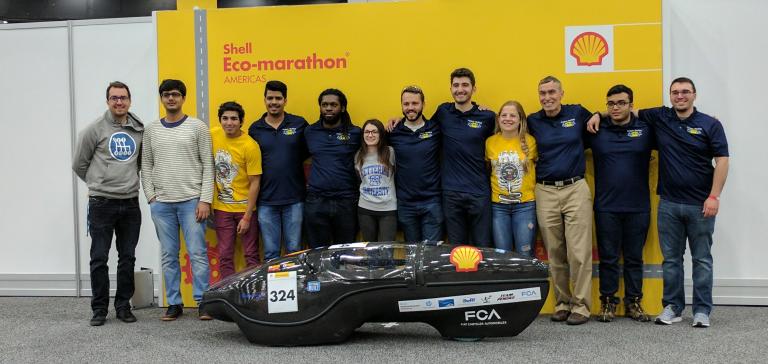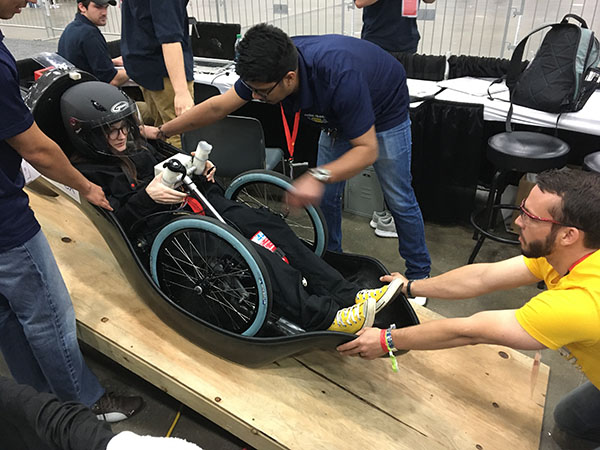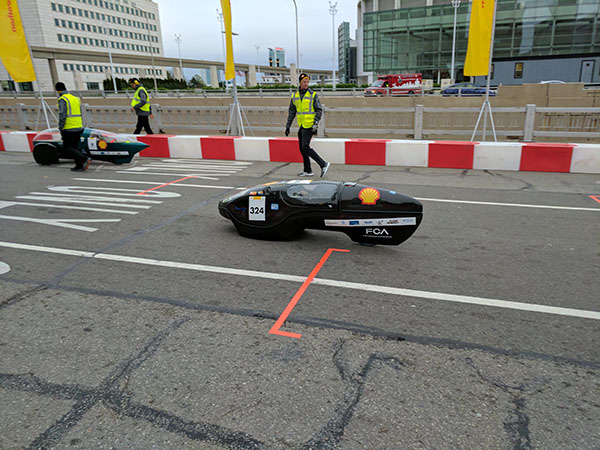
“It’s about really getting that hands-on experience and looking at what it’s going to do for you and the skills you will get out of it. If you go through school and just go to class I think you are really missing out.”
After almost a year of preparation, Kettering University’s Shell Eco-marathon team competed in their first Americas competition in Detroit in April 2017.
The Kettering team, Electric Bulldog, was one of 114 teams that participated outside of Cobo Center for the competition, where the teams either competed under the prototype category or the urban concept category. Electric Bulldog was one of 27 teams to compete with a battery electric powertrain in the prototype category and finished in 11th place.
“We did amazing. We did way better than we thought we would. The car was beautiful.
I am proud of the work we did. I think we represented Kettering very well,” said Jamie Everhart ‘18, Shell Eco-marathon team leader. “We overcame every obstacle you can. Every system we had broke, but we learned a lot throughout the process. We had to redo our steering, braking, re-cut into our body during the competition.”
But when all was said and done, the Kettering team had a product they could be proud of, Everhart said.
For the battery electric category, the goal of the competition was to build a safe, one-person vehicle that is designed to maximize energy efficiency. The teams had 24 minutes to complete a 6-mile track. With a joule meter hooked up to the car, they were evaluated on completion time and efficiency.
Kettering’s team had two of their four runs qualify. The other two were not completed in the allotted 24 minutes.
But their technical inspection was the highlight, Everhart said.
“As an engineer to have someone say you’ve built your vehicle correctly means you did your job,” he said. “It was extremely relieving to have the car on the track. The hard work was worth it. The car was shiny and looking good. We got there.”
The team’s car achieved 165 km/kWh, which is equivalent to about 3,450 MPG, and they did that with zero tailpipe emissions.

Students used state-of-the-art carbon fiber construction, 3D printed parts and student designed electronic control circuits. They designed steering systems, braking systems, and electronic driver instrumentation systems. Essentially, they built the car from the ground up.
“The Electric Bulldog Shell Eco-marathon team had an outstanding showing at the 2017 Americas competition. They showcased outstanding technical engineering expertise with their lightweight carbon fiber chassis and efficient battery-electric powertrain,” said Dr. Mark Thompson, Interim Department Head of the Electrical and Computer Engineering Department and faculty advisor to the Shell Eco-marathon team. “The car passed all the technical inspection criteria with flying colors -- it was built very well and safely designed -- and continued on to perform extremely efficiently on the track.”
Getting to the competition took a lot of work for the Kettering team. The preparations started in May 2016. From there, they formed a team and planned how to make everything come together. The design and building work started that fall.
One of the more difficult tasks was building the shell of the car. The mold was 11 feet long and weighed 300 pounds and had to be shipped in from Canada.
Once the team had that they started working on steering in the fall and coming up with ideas for the braking system. With a carbon fiber body, it made the process more delicate and complex, Everhart said.
“It was a whole new experience. I was learning and reading about vehicle dynamics and teaching myself composites,” Everhart said.
Thompson’s fall EE490 capstone class built the car’s powertrain, which included a power controller board, driver instrumentation and a Joule (energy) meter.
“It was a lot of late nights, a lot of machining. Parts needed to be made and remade and we needed to integrate the powertrain into the car, make the windows and work on body fabrication,” Everhart said. “I think when you go sit down with an employer it looks good. It’s about really getting that hands-on experience and looking at what it’s going to do for you and the skills you will get out of it. If you go through school and just go to class I think you are really missing out.”
Being involved in Shell Eco-marathon has taught the team problem solving on the fly, Everhart said. As they built the car and got it ready for competition there were many opportunities to fix, change and improve the design.

Everhart is looking to grow the Electric Bulldog team in hopes of competing in the urban concept category next, which would take more work and a bigger team.
Anyone interested can visit kettering.edu/shelleco for more information or email Everhart at ever7299@kettering.edu.
The car from this year’s competition is on display in the Electrical and Computer Engineering Senior Design Laboratory on the second floor of the Academic Building, Room 2-819.